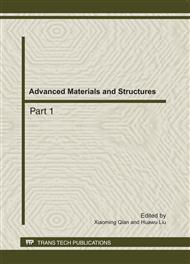[1]
Ashour O, Rogers CA, Kordonsky WI,Magnetorheological fluids: materials, characterization, and devices, Intelligent Material Systems and Structures ,v7 (1996):123.
DOI: 10.1177/1045389x9600700201
Google Scholar
[2]
Bossis G, Khuzir P, Lacis S, Volkova O. Yield behavior of magnetotheological suspensions. Journal of Magnetism and Magnetic Materials, v258-259(2003)456-458
DOI: 10.1016/s0304-8853(02)01096-x
Google Scholar
[3]
Furst Eric M, Gast Alice P. Micromechanics of Magnetorheological Suspensions. Physical Review E: Statistical Physics, Plasmas, Fluids, and Related Interdisciplinary topics, 2000, 61(6).
Google Scholar
[4]
CHEN Hui yu; LI Zhi chao; ZHANG Pei qiang. The Fibre Beam Modelling and Experiment on Magnetic Rheological Fluid. Journal of Experimental Mechanics, volume 15 4th period: 361-365
Google Scholar
[5]
Lu Shouci, Industrial Suspensions-performance, modulation and processing, Chemical Industry Press, 2003.5(106-148)
Google Scholar
[6]
Ozaki M. et al. J. Reversible ordered agglomeration of hematite particles due to weak magnetic interactions, Journal of Colloid and Interface Science. 1986, Vol. 113, No.1 76-80.
DOI: 10.1016/0021-9797(86)90207-9
Google Scholar
[7]
Pashley R M, Israelachvili J N. Comparison of surface forces and interfacial properties of mica in purified surfactant solutions, Colloids and Surfaces. 1981.(2): 169-187
DOI: 10.1016/0166-6622(81)80006-6
Google Scholar
[8]
HUANG Jin ; WANG Hua-pei 1; LING Jan, Research on the Chain-model of the Transmission Mechanical Property of the Magnetohydrological Fluids, Machine Design and Manufacturing Engineering,volume 30 2nd period:3-4.
Google Scholar
[9]
Ginder J M, Nichols M E, Elie L D, Clark S M. Controllable-stiffness components based on magnetorheological elastomers. Proceedings of SPIE –The International Society for Optical Engineering,v3985(2000):418-425
DOI: 10.1117/12.388844
Google Scholar
[10]
Genc Seval, Phule Pradeep P. Rheological properties of magnetorheological fluids. Smart Materials and Structures, v 11, n 1,(2002):140-146
Google Scholar
[11]
Tang Xinlu, Conrad Hans. Analytical model for magnetorheological fluids. Journal of Physics D: Applied Physics, v 33, n 23,(2000):3026-3032
DOI: 10.1088/0022-3727/33/23/304
Google Scholar
[12]
Li WH, Chen G, Yeo SH. Magneto-rheology of reduced iron/silicone oil suspensions. American Society of Mechanical Engineers, Pressure Vessels and Piping Division (Publication) PVP, v 396(1999):351-356
Google Scholar
[13]
Bossis G, Lacis S, Meunier A. Magnetorheological fluids. Journal of Magnetism and Materials, v252(2002):224-228
DOI: 10.1016/s0304-8853(02)00680-7
Google Scholar
[14]
Felt D W (California State Univ), Hagenbuchle M, Liu J, et. Rheology of a magnetorheological fluid. Journal of Intelligent Material Systems and Structures, v 7, n 5(1996):589-593
DOI: 10.1177/1045389x9600700522
Google Scholar
[15]
Lemaire E, Bossis G, Grasselli Y. Yield stress and structuration of magnetorheological suspensions. Journal of Magnetism and Magnetic Materials, v122,n1-3(1993):51-52
DOI: 10.1016/0304-8853(93)91037-8
Google Scholar


